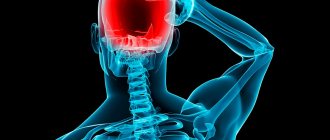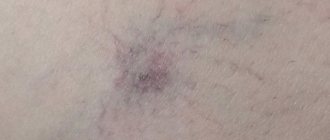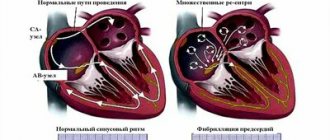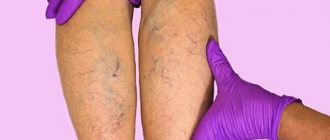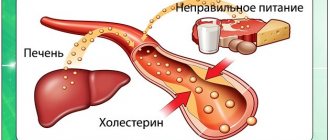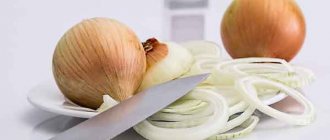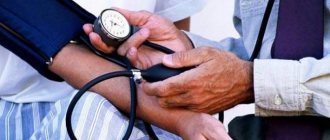Atherosclerotic plaques are the direct cause of the development of such an insidious and dangerous disease as atherosclerosis. The pathology is characterized by changes in the condition of the vessels, which become fragile, lose elasticity, their lumen narrows, and neighboring organs do not receive enough oxygen and nutrients.
The formation of plaques can begin at a fairly young age, but pronounced signs of atherosclerosis appear more often after a person reaches 50 years of age. Today we will talk about why deposits form on the walls of blood vessels, what they are, and methods for timely diagnosis and treatment.
What are cholesterol plaques
Each human organ receives nutrition from vessels, of which there is a huge and extensive network in the body. Blood flowing through the vessels is not a solution, but a suspension, when a suspension of cells, called formed elements, floats in the liquid. The liquid part of the blood does not at all resemble water, which is explained by the molecules dissolved in it, mainly of a protein nature. But various products of fat metabolism also “float” in the blood, in particular cholesterol, triglycerides, and lipoproteins.
According to the laws of physics, blood moves through the vessels in such a way that it is practically free of cells, and most of the formed elements “go” along the edges, representing a kind of “quick response department”: in response to damage to the vessels, platelets immediately descend from here, “closing” gap.
The liquid part of the blood also comes into contact with the vascular walls. As we remember, the products of fat metabolism are dissolved in it. There are several different ones, cholesterol is only one of the components. This system is structured as follows: normally, “bad” fats are in balance with their antagonists, “good” fats (“good” cholesterol). When this balance is disturbed - either the number of “bad” ones increases, or the volume of “good” ones decreases - fatty tubercles - plaques - begin to be deposited on the walls of arterial vessels. The risk of depositing such plaques is judged by the ratio of good fats (they are called “high-density lipoproteins” - HDL) and the sum of low-density lipoproteins (LDL) and very low-density lipoproteins (VLDL). This can be done using a blood test from a vein, called a lipid profile.
Such a plaque is dangerous in the following ways:
- It can come off and, having passed with the blood flow to a vessel of “suitable” diameter, clogs it, thereby depriving the area feeding from there of some kind of nutritional organ. The smaller the vessel, the smaller the area that dies, the less the functioning of this organ and the body as a whole is disrupted (there is “duplication” within the tissue of each organ, thanks to which each “piece” receives nutrition from several small-diameter vessels at once).
- The blood is forced to bypass the plaque, as a result of which, instead of a uniform flow in the vessel, “vortices” are created when part of the blood flowing near the wall covered with the plaque has to return back. Turbulence in the blood flow impairs the nutrition of the blood supply to the organ. Here the relationship is the same as in the point above: the larger the diameter of the artery damaged by the plaque, the more the organ suffers.
- If the composition of the blood does not change, and the amount of HDL and enzymes that should “break off” the plaque does not increase, the body tries to limit it. To do this, he sends immune cells to the site of plaque deposition, whose task is to “bite off” pieces of the plaque and digest them. But the cells are unable to do this: instead of digesting, the immune cells are damaged by cholesterol and fats, and remain “lying” around the cholesterol. Then the body decides to cover this formation with connective tissue, and the plaque increases in size even more, now worsening the blood supply to the organ not only due to turbulence, but due to a decrease in the lumen of the vessel.
- Covering with connective tissue is good for the plaque and bad for the vessel. Now, if something damages the plaque, it will “call” platelets to itself, which will form a blood clot on its surface. This phenomenon, firstly, will further reduce the diameter of the vessel, and secondly, it will increase the risk (especially in vessels with “active” blood flow) of a blood clot breaking off and blocking a smaller vessel.
- A long-existing plaque becomes covered with calcium salts. Such a wall formation is already stable and will not come off without intervention. But it tends to grow and reduce the lumen of the vessel.
The rate of plaque formation is affected by:
- consumption of animal fats;
- smoking;
- diabetes;
- excess weight;
- physical inactivity;
- high blood pressure;
- binge eating;
- eating large amounts of simple carbohydrates with food.
The localization of plaque deposition is unpredictable: it can be either the arteries supplying the brain or the arteries of the kidneys, limbs or other organs. Depending on this, they can cause:
- ischemic stroke;
- angina pectoris;
- myocardial infarction;
- intestinal gangrene;
- aortic aneurysm;
- discirculatory encephalopathy, which is manifested by memory deterioration, headaches, decreased ability to analyze what is happening;
- deterioration of blood supply to a larger or smaller area of the limb, up to its gangrene;
- if the plaque blocks the aorta in the area where large vessels originate from it to each of the lower extremities, both legs will suffer only from ischemia or gangrene.
1-7: Fruits and vegetables
The main benefit of vegetables and fruits for blood vessels is the presence of a large amount of vitamins, as well as fiber, which is not digested or absorbed by the body, but takes part in metabolism (promotes intestinal motility and removes toxins and dense feces from it). What fruits and vegetables are rightfully considered necessary for our vessels?
Lemon
Lemon is known to cleanse arteries. It is one of the largest sources of ascorbic acid (vitamin C), which is involved in the oxidation of cholesterol and stimulates its breakdown into derivative elements.
Moreover, it predominantly reacts with low-density cholesterol, which is usually called “harmful”.
Doctors recommend consuming at least 50 grams of fresh lemon weekly (during heat treatment or, for example, adding citrus to tea, most of the ascorbic acid breaks down into derivatives).
Beet
Beets have an anti-cholesterol effect. This vegetable is one of the largest sources of fiber. Its frequent consumption significantly reduces the risk of developing chronic intestinal diseases.
And beets also help get rid of accumulated toxins , thereby “speeding up” metabolism - “complex” animal fats are absorbed much more actively, cholesterol practically does not accumulate in the circulatory system.
Celery
Celery is good for the heart. It also contains the lion's share of fiber, and it also contains elements such as tyrosine, aspargine, and carotene.
It also contains a whole combination of essential oils (which give the plant its specific taste), which enhance the functioning of the endocrine system, in particular the synthesis of enzymes.
Celery brings the most benefits to the gastrointestinal tract, and indirectly it regulates lipid metabolism.
Pumpkin
Nutritionists say that pumpkin is one of the best sources of “simple” carbohydrates, which are absorbed by the body within 30 to 50 minutes after consumption.
But pumpkin seeds, which contain a fairly large amount of essential oil, are no less useful - it acts as an irritant to the entire digestive system and enhances peristalsis.
And pumpkin oil contains a considerable amount of unsaturated fatty acids - the best option for those who are overweight.
Onion
Although onions are not sour, they contain only slightly less ascorbic acid than lemon and other citrus fruits. In addition, it contains a combination of rare essential oils that stimulate the production of enzymes.
For information on the effect of onions on the cardiovascular system, see a separate article.
They also act as a bactericidal agent, reducing the likelihood of developing infectious diseases.
Doctors also say that daily consumption of red onions (they contain a large amount of iodine) significantly reduces the likelihood of developing diseases of the pancreas and gall bladder - these organs are one of the most important in the entire digestive system.
Ginger
Also rich in vitamin C and specific essential oils.
It acts as an irritant and a long-acting antibacterial agent (that is, the positive effect of its use will be observed after several weeks).
Read more about the benefits of ginger for blood vessels and the heart here.
And ginger root and tea based on it have a positive effect on overall tone. The substances it contains stimulate the absorption of protein and fats, thereby reducing the likelihood of the formation of atherosclerotic plaques . It should be used with caution by those who have problems with the reproductive system (in particular, the prostate gland).
Horseradish
Most of the horseradish root, which is used in cooking, is occupied by fiber and essential oils with a powerful antibacterial effect.
reduces the likelihood of developing chronic diseases of the cardiovascular system by almost 10 times . It also helps normalize blood pressure in hyper- and hypotensive patients. Horseradish is also a product that lowers sugar levels, thins the blood and reduces hemoglobin.
How to determine if there are cholesterol plaques
Before cleaning blood vessels from cholesterol plaques and blood clots, you need to find out whether they are there or not. If the lipid profile shows the risk of plaque formation, the coagulogram shows the risk of thrombus formation, then instrumental studies will help to detect immediate “congestion” in the vessels:
- A special type of ultrasound is color duplex scanning. In this way it is very convenient to examine the arterial and venous vessels of the upper and lower extremities, the aorta, vessels going to the brain and those that nourish the retina;
- Triplex scanning is another option for ultrasound. It is used to examine the vessels of the brain and the arteries that supply it - those located outside the cranial cavity;
- The most accurate research method is angiography. It is used to clarify the location of plaques/thrombi in the vessels of the extremities that were identified during duplex or triplex scanning, as well as to determine blood clots/plaques in those organs that cannot be seen during ultrasound examination.
Interesting Facts
World-famous cyclist Lance Armstrong was diagnosed in 1996 with an advanced form of testicular cancer with metastases to the lungs, abdomen and brain. Many experts believed that he was incurable; he was given only a 20% chance of survival. After a series of operations and many courses of aggressive therapy, Armstrong finally survived. In addition, in 1998, Lance took 4th place in the prestigious multi-day cycling race.
After his recovery, Armstrong created an anti-cancer movement and a foundation to fight cancer. In 2000, the cyclist published his book “My Return to Life.” Lance is still alive and well.
When to clean vessels
You need to clear cholesterol from your blood vessels when:
- According to instrumental methods, atherosclerotic plaques were detected or
- when there is already a violation of internal organs, against the background of which a high atherogenic index is detected (according to lipid profile). These are: cholesterol above 6.19 mmol/l;
- LDL – more than 4.12 mmol/l;
- HDL: below 1.04 for men, below 1.29 mmol/l for women.
In the following cases, it is necessary to do everything possible to prevent the deposition of cholesterol on the walls of blood vessels:
- men over 40 years old;
- women over 55 years old;
- if you have bad habits;
- if a person eats a lot of smoked, fried, salty food, meat;
- if relatives have atherosclerosis, ischemic or hypertension;
- suffering from diabetes mellitus;
- those who note the presence of excess weight;
- those who have suffered a complication of streptococcal infections such as rheumatism;
- if at least once there was numbness of one limb or half of the body, which did not follow their compression, but arose “by itself”;
- if at least once there was a visual impairment in one eye, which then went away;
- when there was an attack of sudden general weakness;
- if there is causeless pain in the navel area, accompanied by flatulence and constipation;
- when memory deteriorates, and the desire to rest causes less and less mental stress;
- if it becomes more and more difficult to walk, your legs hurt with less and less load;
- when there is chest or cardiac pain that is not relieved by nitroglycerin;
- if the hair on your legs falls out, and your legs themselves turn pale and freeze;
- if any ulcers, redness, or swelling begin to appear on the lower extremities.
8-10: Berries
The composition of the berries necessary for blood vessels is quite similar to ordinary fruits, but they have several significant advantages:
- high content of “complex” glucose (therefore they can be included in the diet for diabetes);
- the presence of fatty oils (which can replace animal fats);
- a wide combination of vitamins (there are over 10 of them in rowan).
Kalina
In addition to vitamin C and B vitamins, it contains phytosterols - a class of substances of plant origin that act as mediators on the human body. That is, they provoke various kinds of biochemical processes.
Phytosterols, which are found in viburnum, accelerate the absorption of vitamin E, which is precisely necessary for normal hematopoiesis.
Viburnum also helps remove accumulated toxins from the blood. Moreover, it is better to use it in dried form.
Cranberry
Cranberries contain a huge amount of vitamin C, so it is almost impossible to consume them fresh. But it is an excellent preservative.
And the tincture of cranberries with garlic and lemon helps make blood vessels more elastic - in this case, cholesterol is practically not deposited on them even in old age.
Cranberry slightly helps to slightly dissolve atherosclerotic plaques, accelerating the breakdown of lipids. But you still won’t be able to completely get rid of them.
Rowan
Black rowan is more suitable for cleansing blood vessels. Its key benefits are lowering low-density cholesterol levels and increasing the synthesis of erythrocytes (red blood cells).
Just keep in mind that in excess, rowan can be harmful. Most often this ends in gastritis or stomach ulcers .
How to clean blood vessels from atherosclerotic plaques
The program for cleaning blood vessels from cholesterol deposits on their walls should be carried out by a doctor based on the results of laboratory and instrumental studies. It must include:
- lifestyle changes if they lead to the formation of plaques;
- adherence to a diet that will lead to the normalization of the functioning of the digestive organs, so that “good” cholesterol is best absorbed;
- a diet that will prevent blood clots.
According to indications, the following may be prescribed:
- medications that reduce blood cholesterol levels;
- drugs that reduce blood viscosity;
- folk remedies aimed at normalizing blood viscosity or reducing cholesterol levels.
11: Honey
The main benefit of honey for the cardiovascular system is the presence in its composition of a wide range of vitamins and minerals, which together normalize the biochemical composition of the blood.
All this helps to optimize the salt balance and reduce the concentration of sodium in the body (which is excreted primarily through the urinary system). The most useful combinations with honey are the following:
- Lemon with honey. Not only reduces cholesterol, but also improves the biochemical composition of the blood. Indirectly, it also reduces the likelihood of cancer (as free radicals in the blood and lymph are neutralized).
- Honey and cinnamon. Doctors say that this combination will bring more benefits to men, since cinnamon significantly increases blood flow in the pelvic organs (this includes the prostate gland). However, this remedy helps well with varicoceles and varicose veins.
- Cranberry, honey and garlic. It has a healing effect on the vessels themselves, improving their elasticity. It also prevents spasms, which often causes blockage of venous valves.
12-17: Herbs and fees
Many medicinal herbs and cleansing decoctions based on them are certified for use in official medicine - this only confirms their effectiveness. Cloves and horse chestnut are considered the most beneficial for the cardiovascular system. At the same time, their main active components are phytoncides - biologically active components that stimulate many chemical processes in the body (including the breakdown of cholesterol).
Altai tea
Altai tea comprehensively improves the functioning of the cardiovascular system and also reduces the risk of heart attack . Acts as a sedative, improves the conductivity of the sinus node.
In combination with lemon, it also reduces low-density cholesterol (without any effect on high-density cholesterol, which is beneficial).
Clover
Various kinds of infusions and decoctions with clover have a positive effect on the nervous system. Acts as a somatic remedy, but without any consequences.
It slightly reduces blood pressure, so if you have hypertension, be sure to include it in your diet.
horse chestnut
Its fruits are considered poisonous, so flowers and prickly skins are used in folk medicine.
Chestnut practically eliminates the risk of developing atherosclerosis, but at the same time it slightly increases blood pressure.
Pine cones
It is the “green cones” that should be used to clean the vessels. Moreover, they should be collected precisely in the forest, and not in dense urban areas.
See the recipe for tincture on cones here.
Pine itself actively absorbs toxins, but the cones contain a large amount of tannins, resins and essential oils.
Carnation
The taste of clove-based infusions is quite specific. But with its help you can significantly strengthen the immune system , and also improve the elasticity of blood vessels and normalize the functioning of venous valves.
Flax seeds
The main benefit is for the digestive system. They normalize lipid metabolism and also accelerate the breakdown of cholesterol.
Doctors also claim that a decoction of flaxseed reduces the likelihood of constipation and diarrhea to a minimum.
18-20: Other products
There are many more foods that can be used to lower cholesterol. Ideally, you should consult a nutritionist on this matter, as he can select an individual diet taking into account the patient’s requirements. “Universal” products of this kind include walnuts or apple cider vinegar.
Propolis
Propolis is no less beneficial for blood vessels than honey. At least there are more minerals in the composition.
However, it may cause an allergic reaction. It's better to start with small doses . It is better to prepare alcoholic infusions with propolis. They are especially useful for diabetes.
Baking soda
Oddly enough, soda can also be used for cleansing. The positive effect is achieved by regulating salt metabolism and accelerating the elimination of sodium combinations.
This is extremely important for the heart.
Apple vinegar
Apple cider vinegar contains a combination of organic acids, many of which literally break down cholesterol and lipids.
But you should use it carefully - no more than 100 milliliters per week. If more, there will be harm to the cardiovascular system.
Also pay attention to the infographic:
